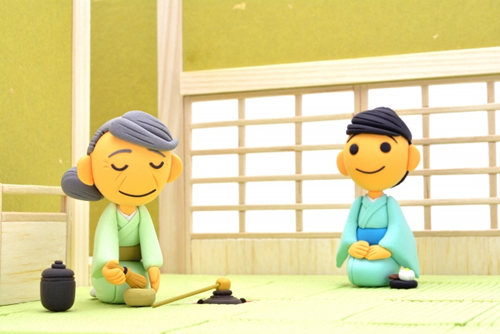Posted by TOKYO MATCHA SELECTION on 6th May 2017

Japanese tea ceremony originally came from China. It was Chinese style then. Many Japanese tea masters have developed it and completed it. If you would learn about the history of Japanese tea ceremony, you might get close to the world of Japanese tea ceremony.
Matcha coming to Japan
Matcha, which is used for Japanese tea ceremony, came to Japan about eight hundred years ago. At that time, Japan was in the period of Kamakura. It is said that Eizai (Eisai), Zen master, told about matcha.
Eizai went to China and learned Buddhism. At that time, he brought the seeds of matcha to Japan. He offered matcha to the General of Kamakura government who was suffering from hangover as he knew drinking matcha would ease the hangover symptoms. Eizai wrote a book about how to drink matcha and its effects. People got to know matcha from the book.
Matcha has spread among monks
Eizai presented the seeds of matcha to a disciple who worked for a temple. The disciple planted the seeds and made matcha. Monks of temples started to drink matcha. Matcha has spread among monks.
"Toucha"
In the period of Muromachi, "Toucha" became trend among samurai. Toucha was a game which came from China. The game was played according to rules and a lot of money was bet sometimes. Since Toucha became trend, matcha was spread among the general public as well. However, Toucha was banned by the General at that time.
The birth of Japanese tea ceremony
In the period of Muromachi, "Shointsukuri" became famous among samurai. Shointsukuri was one of styles of home. The culture of Japanese tea ceremony developed with Shointsukuri. There were paintings, tea ware, and utensils from China in the home of Shointsukuri. People welcomed guests and offered matcha in one of rooms.
Japanese tea ceremony has developed originally since then and the influence of China has reduced gradually. At this time, a master made matcha in another room then moved to the room where a guest waiting and offered it there. Nowadays, a master made matcha in front of a guest.
Wabicha by Juko Murata
In the period of Muromachi, Japanese tea ceremony used expensive utensils called "Karamono"(唐物). Karamono is a thing from China. People tried to show off things and compete with others in Japanese tea ceremony. Against the Japanese tea ceremony which value expensive utensils, Juko Murata, who was a Zen monk, established "Wabicha" of Japanese tea ceremony. Juko put the mind of Zen into Japanese tea ceremony and add simple Japanese tools to the ceremony instead of expensive Karamono. Juko wrote a book about Japanese tea ceremony. In this book, he sees Japanese tea ceremony as a tool to polish one's mind and taught harmony of Karamono and Wamono, which is made in Japan. The book said that the worst thing in Japanese tea ceremony is to make fool of other person and to be selfish. It also said that you should be kind to a person who learns Japanese tea ceremony for the first time. Many Japanese tea masters were influenced by his book.
Sen no Rikyu
After Juko passed away, his disciple, Jouou Takeno, had learned and developed Wabicha. Jouou taught his disciple, Sen no Rikyu, about Wabicha. Sen no Rikyu tried to establish Japanese tea ceremony which gets rid of aspect of play and values the interchange of people's heart. Sen no Rikyu also asked a craftsman to make new matcha bowl and other utensils for Japanese tea ceremony.
He learned Zen as well and reached the mental state of "Chazenichimi" (茶禅一味). Chazenichimi means that Japanese tea ceremony and Zen are united as one. Zen training requires calm and peace mind and its goal is to purify one's mind. Sen no Rikyu adopted the teaching of Zen to Japanese tea ceremony.
Juko started Wabicha and Sen no Rikyu completed it. Japanese tea ceremony of Sen no Rikyu has still passed on nowadays.
Japanese tea ceremony became politicized

Between the 16 century and the 17 century, Japanese tea ceremony became glorious. In this era, Nobunaga Oda became the ruler of Japan. He collected "Meibutsu"(名物) which is valued utensils from ancient time. Meibutsu became the symbol of power and wealth of the ruler. Nobunaga used Japanese tea ceremony for politics and gave permission to have Japanese tea ceremony for specific samurai. Hideyoshi Toyotomi, who was the next ruler of Japan after Nobunaga, pushed forward Japanese tea ceremony politically.
Sectionalism of Japanese tea ceremony
In the period of Edo, some sects of Japanese tea ceremony were born. Three grandchildren of Sen no Rikyu made Sansenke, Omotesanke, Urasenke, and Mushanokoujisenke. They established "Iemoto" system that Iemoto plays a central part and take a leadership role in the development of the style. Sansenke is major sect of Japanese tea ceremony now.
Japanese tea ceremony in modern era
In the period of Meiji, samurai who supported Japanese tea ceremony had disappeared. In addition, Japan tried very hard to adopt Western culture. So, the momentum of Japanese tea ceremony declined at this time.
However, woman's education adopted Japanese tea ceremony and many women began to learn. Nowadays, Japanese tea ceremony is recognized as one of major traditional Japanese culture.